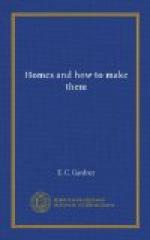There are two ways of lessening the evil without exterminating the cause. One is to shut the room, never using or opening it, except for the spring and fall cleaning; the other is to lay the carpet in such way that it may be taken up and relaid without demoralizing the entire household. Talk about the carpets fitting the rooms; there should be a margin of two feet—a few inches, more or less, is unimportant—at each side. Then if you have a handsome floor, the carpet becomes a large rug—no matter how elegant—that may be removed, cleansed, and put back again every morning if you like. You may fancy a border of wood either plain or ornamental, the surface of which shall be level with the top of the carpet. This is easily made, either by using thicker boards around the edges or by laying wood carpeting over the regular floor. One caution concerning fancy floors; don’t make them too fanciful. We don’t like to feel that we’re treading under foot a rare work of art, and I’ve seen certain zigzag patterns which merely to look at fairly makes one stagger. Thresholds are on the floor, but not of them, nor of anything else, for that matter, and though somewhat useful in poetry, are often provoking stumbling-blocks in practice. Necessary at times, doubtless, but we have far too many and too much of them. Even where rooms are carpeted differently they are not needed. If you must have them, let them lie low and keep dark.
[Illustration: WOOL AND WOOD.]
If you paint or paper the walls, as you will if they are plastered, keep this in mind: the trowel finishes them as far as use is concerned. Whatever is added is purely in the nature of ornament, and must be tried by the laws of decoration. If you enjoy seeing “a parrot, a poppy, and a shepherdess,” bunches of blue roses, and impossible landscapes, spotted, at regular intervals, over the inner walls of the rooms, you will choose some large-figured paper. Perhaps, if the pattern is sufficiently distinct and gorgeous, you will think you need no other pictures; and the pictures themselves will be glad to be left out if they have any self-respect. I’m sure you don’t enjoy any such thing. Some of the fancy paper-hangings are artistic and beautiful in design; for that very reason they ought not to be repeated. I would as soon hang up a few dozens of religious-newspaper prize-chromos. The general effect is the point to be considered. Why not have both? Because you can’t. When you have a picture so pretty and complete as to attract your attention and fix itself in your memory, the general effect is lost if you discover the same thing staring at you whichever way you turn. ’T is the easiest thing in the world to have too much of a good thing. Sometimes the better the thing the worse the repetition. This general effect which we must have is well secured by a small, inconspicuous figure, or by those vine-like patterns, so delicate and wandering that you don’t attempt to follow




